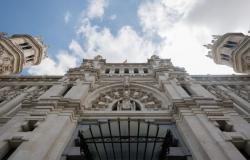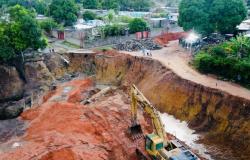Javier Distefano with his steep guitar (photos: Facundo Pardo).
He Buenos Aires fillet It is a particular art, very clinging to the spirit of Buenos Aires. So much so that, beyond the globalized news calls to generalize without taking into account the roots, the activity still marks a close relationship with the Argentine capital, although it can be found in other parts of the country.
Read also: from Bariloche to the World: Buenos Aires Book Fair, Cannes Creativity Festival and an exhibition in a Slovak castle
It is a painting style that is characterized by lines that become spirals, strong colors, the use of symmetry, almost three -dimensional effects from shadows and perspective methods, all with some overload of the treated surface, which can be from a vehicle to a wall, passing through everything that is imagined.
Javier Distefano He ran into the technique on a filming set.
He was just over twenty years old when in Baires studies, where he served as a scenographic filmmaker, he met a teacher in practice, Untroib Leonauthor of a well -known work on Carlos Gardel who adorns the Buenos Aires subway station that bears the name of the Zorzal.
At that time, a movie called Naked tango (Naked tango), with an international cast that included the Spanish Fernando Rey and the American Vincent d’Onofrio, an actor who would later popularize for participating in the series Law & Order: Criminal Intent (In Argentina, Law and order).
The film, based on the so -called Zwi Migdal Society, which, according to Javier, “was the Jewish Polish mafia that brought European girls deceived to put them in Argentine brothels.”
“As it was a film set in the twenties, they summoned León Untroib to do a decoration job,” recalls Javier, who remarks: “When I saw him work, I went crazy.”
“I asked him if he taught, and he told me that he had never done it, but that, if he wanted, he could go to barbe and see how he worked,” he evokes.
This is how he began to attend his study. “I kill him as he was dicing what he was doing,” he says, and with a smile he adds: “When I returned to my house, I practiced in the windows of the windows.”
Now, with sixty years, he makes known a book that has the fillet as the main actor, although, in reality, the technique shares prominence with literature and music.

The artist and the work.
The multidisciplinary work is titled Paputza and all heavenand will be presented in Bariloche Today –jos 8– at 13 in the Provincial Administrative Center, Located in Oelli 1450.
Javier created a universe of Porteña legend, with various stories crossed by a central character, the paputza of the title, whom he defines as “a envoy of ‘the ancients’ to modify people’s behaviors, for better or bad, depends on the attitude they have towards life; that is, it comes to beautify the environment.”
These are seven fables that arise from a different picture each, creations that appear reproduced in the book. “It is a resignification of the language of the Buenos Aires fillet, because, in general, this art is used as ‘the framework of’ – a portrait, a landscape, a phrase … -, and here, on the other hand, it becomes the central figure. In addition, instead of being treated with synthetic enamel on tables or plates, it is made in web on cloth,” explains Javier.
But, as indicated, there is also the music, since the book contains a QR code that allows access to an adage in my minor, also composed of Javier, although piano arrangements and interpretation were borne by Germán Lema, who resides in Bariloche.

Javier lived in Bariloche, and now he returns to present Paputza and all heaven.
Javier has a deep relationship with this town. A native of San Martín, Buenos Aires, lived six years in Bariloche, between 2015 and 2021. I gave classes at the National University of Comahue of fillet and muralism, ”he says.
He returned to Buenos Aires for an inconvenience of health. “I started having vertigo, I was dizzy all the time, and they sent me to the neurologist. At the Bariloche hospital it took a long time to get a turn, so I returned to Buenos Aires. There they attended me, they referred me to another specialty and they diagnosed me vertigo for emotional stress. I still have it. If I do not take the medications, I pass me again,” he details.

Book and coffee, an ideal link.
Beyond that, the current one finds him dedicated to publicizing the book he will present today in Bariloche, a work in which he worked twelve years. “I started with the drawings and painting, and in parallel I began to compose the music (I am self -taught), and with the idea of a book. But I did not come out how to face it from writing. I had never written. At first, when trying to be correct, I came out something type type document. In a super colloquial way, using lunfardo … and there it began to work, ”he says who defines himself as“ someone very restless that from one thing jumps to the other ”, although, these days, he is fully involved in Paputza and all heaven.

The smile for the work done.





